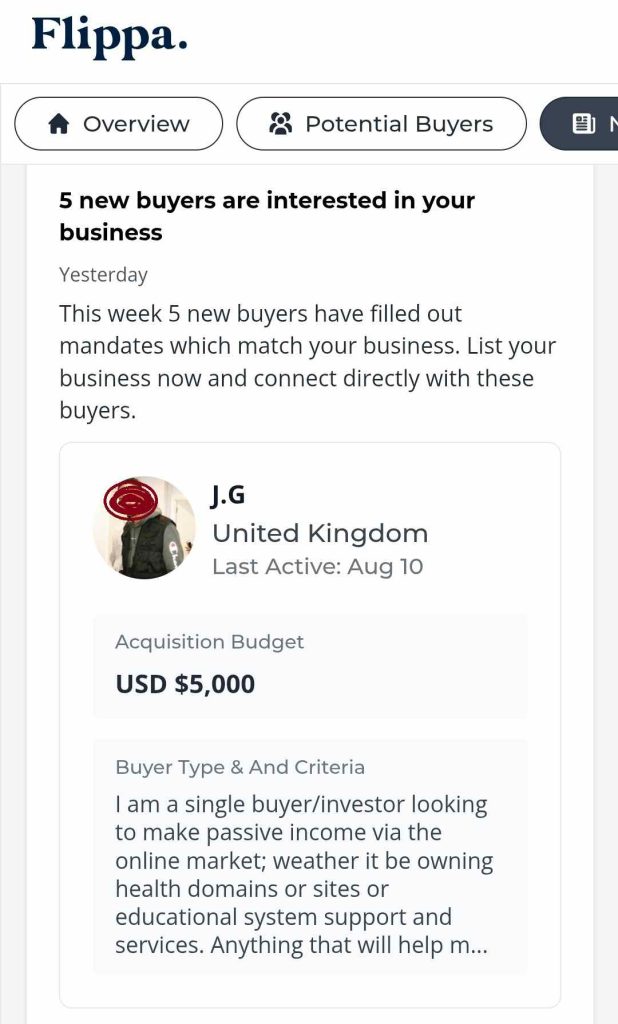by Daniel Nkado

I sincerely apologise for the click-b8. The amount I have made so far is not up to £15K (yet) — around the corners of £8K to be more exact. But, hey, still cool money, right? Especially for a venture that is less than a year old. Some of the domains were bought for less than £300 but were resold for up to £2,000 on Flippa.
Interestingly and rather surprisingly, the growth of AI seems to have doubled people’s (and companies’) interest in viable aged domains.

The Business of Buying and Reselling Aged Domains
1. Understanding Aged Domains
An aged domain is a domain name that has been registered for a significant period (typically over a year) and often has a history of being used for a website. Unlike expired domains, which have not been renewed and are available for re-registration, aged domains are actively registered and may still be in use or parked. Their value stems from:
- SEO Benefits: Search engines like Google often favor older domains due to their perceived trustworthiness and authority. Aged domains may have accumulated high-quality backlinks from authoritative sites (e.g., Forbes, BBC), enhancing their SEO potential.
- Backlink Profiles: Domains with established backlinks from reputable sources can boost a website’s search engine rankings, making them attractive for buyers.
- Brand Potential: Short, memorable, or keyword-rich domain names are easier to market and can command higher prices.
- Existing Traffic: Some aged domains retain residual traffic from past use, which can be monetized immediately through ads, affiliate links, or redirects.
Key Difference: Aged vs. Expired Domains
- Aged Domains: Actively registered, with a continuous history of ownership and often a clean record. They retain their original registration date, preserving SEO value.
- Expired Domains: Domains that were not renewed, passing through a grace period, redemption period, and potentially an auction phase before becoming available for re-registration. Their history may include gaps, and they may carry risks like penalties or spam associations.
2. Why Invest in Aged Domains?
The business of buying and reselling aged domains offers several advantages:
- High Profit Margins: Domains can be purchased for as low as $10–$100 at auctions and resold for hundreds or thousands, especially if they have strong SEO metrics or brand appeal. For example, premium domains like “cars.com” have sold for $872 million, though such sales are outliers.
- Low Overhead: The business requires minimal infrastructure—no need for physical inventory, staff, or large upfront investments beyond the cost of domains and hosting.
- Scalability: Investors can start with a few domains and scale by building a portfolio, using marketplaces to reach a global audience.
- Multiple Use Cases: Aged domains can be used for flipping, building niche websites, creating private blog networks (PBNs), or redirecting to boost existing sites’ SEO.
3. The Process of Buying and Reselling Aged Domains
Step 1: Sourcing Aged Domains
Finding valuable aged domains requires research and access to reliable platforms. Key sources include:
- Marketplaces:
- Odys Global: Specializes in premium aged domains with clean histories and strong backlinks. Offers personalized support and detailed analytics.
- SerpDomains: Focuses on vetted, high-quality domains for SEO and niche sites, with a user-friendly interface.
- SEO.Domains: Claims to hold ~70% of the global supply of aged and expired domains, offering 150,000+ domains across various niches.
- GoDaddy Auctions: Affordable entry with a $4.99 annual membership, ideal for finding deals on aged and expired domains.
- Namecheap Marketplace: Offers competitive pricing and a large user base, making it accessible for beginners.
- Sedo: The largest domain marketplace, with options for fixed-price sales, auctions, and broker services.
- Flippa: Combines domain and website sales, ideal for finding aged domains with existing traffic.
- ExpiredDomains.net: Provides daily lists of expired and deleted domains with SEO metrics like backlinks and age.
- Domain Brokers: Professionals who source exclusive aged domains, though they charge commissions (10–20% of the sale price).
- Backorder Services: Platforms like NameJet, SnapNames, or DropCatch allow users to pre-order expiring domains, automating the acquisition process.
- Direct Outreach: Contacting owners of unused domains to negotiate private sales.
Step 2: Evaluating Domain Quality
Due diligence is critical to avoid purchasing domains with issues like spam penalties or legal risks. Key factors to assess include:
- Backlink Profile: Use tools like Ahrefs, Moz, or Majestic to check for high-quality, relevant backlinks from authoritative sites. Avoid domains with spammy or low-quality links.
- Domain Authority (DA) and Trust Flow (TF): Aim for domains with DA >15 and TF >20, indicating trustworthiness and SEO strength.
- History Check: Use the Wayback Machine (Internet Archive) to review past content and ensure the domain wasn’t used for spammy or adult content.
- Google Penalties: Check the Google Transparency Report to confirm the domain isn’t banned by Google AdSense or crawlers.
- Trademark Issues: Avoid domains that infringe on trademarks to prevent legal disputes.
- Keyword Relevance: Domains with niche-specific keywords (e.g., “cheapestdomainhosting.com”) are more valuable for SEO and branding.
- Traffic Data: Analyze residual traffic using tools like SEMrush or SimilarWeb. Domains with consistent traffic are more attractive.
- Age: Older domains (5+ years) are generally more valuable due to perceived authority. Use WHOIS lookup tools to verify registration date.
Step 3: Purchasing Domains
- Auctions: Bid on platforms like GoDaddy Auctions or NameJet, setting a maximum budget to avoid overpaying. Proxy bidding services can automate incremental bids.
- Fixed-Price Sales: Purchase directly from marketplaces like Odys Global or Sedo for immediate ownership.
- Negotiation: Make offers on “Make Offer” listings to secure domains at lower prices.
- Budgeting: Set a budget to avoid impulsive purchases. Use tools like Estibot.com for automated appraisals based on search volume and comparable sales.
Step 4: Enhancing Domain Value
To maximize resale value, investors can:
- Build a Niche Site: Develop a simple website with quality content to demonstrate value. For example, an affiliate marketer built a camera review site on an aged domain, achieving 20,000 monthly visitors before a Google update impacted traffic.
- Redirect (301): Use the domain to redirect traffic to an existing site, boosting its SEO. This is a common tactic to transfer authority.
- Park the Domain: Park domains with services like Sedo to display ads and generate passive income while waiting for buyers.
- Improve Branding: Enhance the domain’s appeal with a logo or landing page showcasing its potential.
Step 5: Selling Domains
- Marketplaces: List on Sedo, Flippa, or Odys Global for maximum exposure. Sedo reports fixed-price domains sell up to three times faster.
- Auctions: Start auctions to attract competitive bidding and drive up prices.
- Broker Services: Use professional brokers for high-value domains to negotiate better deals, though commissions apply.
- Direct Sales: Reach out to businesses or individuals in relevant niches who might value the domain’s SEO or branding potential.
- Pricing Strategy: Set prices based on comparable sales, SEO metrics, and market demand. Short, brandable domains or those with strong backlinks command higher prices.
Step 6: Transferring Ownership
- Secure Transactions: Use escrow services (e.g., Sedo’s Transfer Service) to ensure payment before transferring ownership.
- Registrar Transfer: Move the domain to the buyer’s preferred registrar using authorization codes. Transfers typically complete within hours to a week.
- Documentation: Provide buyers with domain history reports and analytics to build trust.
4. Strategies for Success
- Portfolio Diversification: Invest in domains across niches (e.g., tech, health, finance) to spread risk.
- Trend Analysis: Target domains related to emerging industries (e.g., AI, crypto) for future appreciation.
- Volume Approach: Purchase multiple low-cost domains to increase the chances of finding a high-value gem.
- Quality Over Quantity: Focus on vetted, high-authority domains for faster sales and higher margins.
- Affiliate Programs: Earn commissions by referring buyers to marketplaces like SerpDomains.
- PBNs (Private Blog Networks): Use aged domains to create networks linking to a primary site, though this is considered gray-hat SEO and carries risks of penalties.
5. Tools and Resources
- SEO Tools: Ahrefs, Moz, SEMrush, Majestic for backlink and traffic analysis.
- Domain Valuation: Estibot.com for automated appraisals.
- History Check: Wayback Machine for past content review.
- Marketplaces: Odys Global, SerpDomains, GoDaddy Auctions, Sedo, Flippa, Namecheap.
- Auction Platforms: NameJet, SnapNames, DropCatch for expired domains.
- WHOIS Lookup: GoDaddy WHOIS or Namecheap for domain age and ownership details.
- Google Transparency Report: To check for bans or penalties.
6. Risks and Challenges
- Liquidity: Domains can take months or years to sell, requiring patience and a long-term horizon.
- Subjective Valuation: Unlike stocks, domain value is subjective and hard to pinpoint, leading to potential overpayment.
- Legal Risks: Trademark infringement or stolen domains can result in lawsuits or forced surrenders.
- SEO Penalties: Domains with spammy backlinks or Google penalties can harm rankings.
- Market Saturation: The domain market is competitive, with multiple bidders driving up prices at auctions.
- Google Updates: Algorithm changes can devalue domains reliant on SEO, as seen in a case where a camera review site lost 85% of traffic post-update.
7. Best Practices
- Set a Budget: Avoid overspending in auctions by defining a maximum bid.
- Due Diligence: Always verify backlinks, history, and penalties before purchasing.
- Stay Informed: Monitor industry trends and Google algorithm updates to anticipate demand.
- Leverage Support: Use marketplace support teams (e.g., Odys Global’s 24/7 assistance) for guidance.
- Avoid Speculative Buying: Focus on domains with proven metrics rather than speculative future value.
- Document Everything: Keep records of purchases, analytics, and sales to track performance and build credibility.
8. Case Studies
- Success Story: An investor purchased an aged domain from Odys Global and built a niche site, achieving 3,000 daily views within six months and $8,000 monthly revenue after ten months.
- Cautionary Tale: An affiliate marketer bought an aged domain with 185 backlinks but relied heavily on commercial content, losing 85% of traffic after a Google algorithm update due to lack of informational content.
9. Getting Started
- Research: Study marketplaces and SEO tools to understand the market.
- Join Marketplaces: Sign up for platforms like GoDaddy Auctions ($4.99/year) or Odys Global (free membership with approval).
- Start Small: Begin with low-cost domains to learn the process and minimize risk.
- Network: Engage with communities on X or forums like NamePros to learn from experienced flippers.
- Track Performance: Use analytics to monitor traffic and sales, refining your strategy over time.
10. Conclusion
Buying and reselling aged domains is a dynamic business that combines research, strategy, and patience. By leveraging the SEO and branding potential of aged domains, investors can achieve significant profits, though success requires thorough due diligence and market awareness. With the right tools, platforms, and strategies, this venture can be a rewarding side hustle or full-time business for tech-savvy entrepreneurs.


